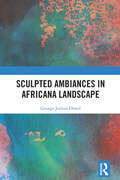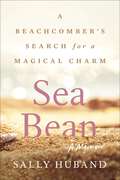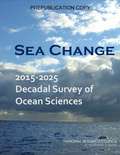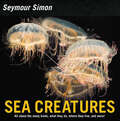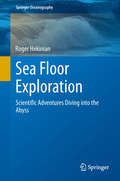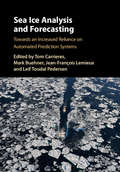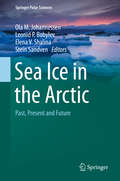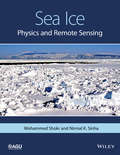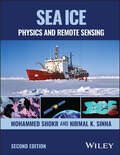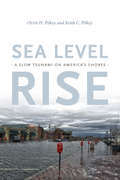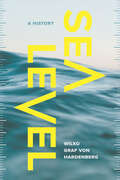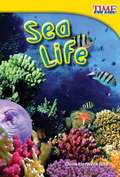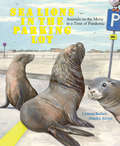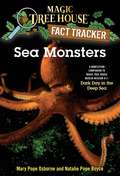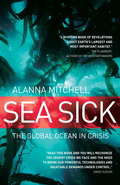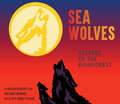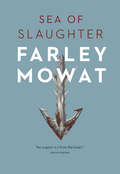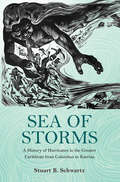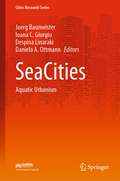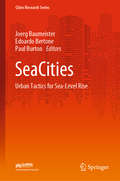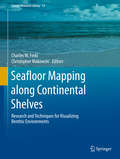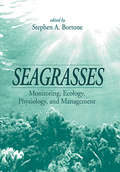- Table View
- List View
Sculpted Ambiances in Africana Landscape
by George Joshua OrwelSculpted Ambiances in Africana Landscape centers on ambiance as it affects the expanded sculptural field, particularly filling a gap in aesthetics left by a lack of focus on sculptures and installations in the Africana world and elsewhere.This book differentiates ambiance from other affective states and emotions and explores its production. It provides an introduction to the history of ambiance and vividly demonstrates, through immersive and experiential writing, how ambiance manifests in different artistic situations and social settings. The book considers the neglected and unique importance of sculptural ambiance to the history of Africana visual culture, and what these works mean in terms of their social, historical, cultural, political, and ecological imagination of space. The book is written in an episodic style and begins with a description of an image before presenting an analysis of the artist’s style and staging for ambient experience.This book will benefit college and university students; scholars of art, architecture, aesthetics, philosophy, geography, anthropology, and sociology; and curators and galleries.
Sea Bean: A Beachcomber's Search for a Magical Charm—A Memoir
by Sally Huband“Sea Bean is a coastal treasure. Its hard-won attentiveness shows the wonder and vulnerability of our interconnected oceans, wildlife, and people. In Sally's writing, beachcombing—an old island pursuit—is modern, revealing and restorative. The next time I am at the shore I will have a deeper appreciation and curiosity."—Amy Liptrot, author of The Outrun and The InstantA Waterstones Nature and Travel Best Book of 2023Winner of the Highlands Book Prize 2023Longlisted for the Wainwright Nature PrizeA powerful journey of sea and self, trial and hope on the islands of Shetland, where climate change is making marked impacts on the natural world.When a seed falls from a vine in the tropics and is carried by ocean currents across the Atlantic to the shores of Western Europe, it is known as a sea bean. It’s long been lucky to find a sea bean upon the shore; these seeds have been collected and used as magical charms for more than a thousand years.Sally Huband's search for the elusive sea bean begins shortly after she moves to the windswept archipelago of Shetland, the northernmost region of Great Britain, situated between the Atlantic Ocean and the North Sea. When pregnancy triggers a chronic illness and forces her to slow down, Sally turns to the beaches for solace and wellbeing. There, she discovers treasure freighted with story and curiosities that connect her to the world.The wild shores of Shetland offer glimpses of orcas swimming through the ocean at dusk, the chance to release a tiny storm petrel into the dark of the night, and a path of hope. This beachcombing path takes her from the Faroese archipelago to the Orkney islands, and the Dutch island of Texel. It opens a world of ancient myths, fragile ecology, and deep human history. It brings her to herself again.Sea Bean is a like a message in a bottle. It reveals the interconnection of our oceans, our communities, and ourselves, and offers both comfort and an invitation to feel belonging when we are adrift.
Sea Change: 2015-2025 Decadal Survey of Ocean Sciences
by Committee on Guidance for NSF on National Ocean Science Research Priorities: Decadal Survey of Ocean SciencesOcean science connects a global community of scientists in many disciplines - physics, chemistry, biology, geology and geophysics. New observational and computational technologies are transforming the ability of scientists to study the global ocean with a more integrated and dynamic approach. This enhanced understanding of the ocean is becoming ever more important in an economically and geopolitically connected world, and contributes vital information to policy and decision makers charged with addressing societal interests in the ocean. Science provides the knowledge necessary to realize the benefits and manage the risks of the ocean. Comprehensive understanding of the global ocean is fundamental to forecasting and managing risks from severe storms, adapting to the impacts of climate change, and managing ocean resources. In the United States, the National Science Foundation (NSF) is the primary funder of the basic research which underlies advances in our understanding of the ocean. "Sea Change" addresses the strategic investments necessary at NSF to ensure a robust ocean scientific enterprise over the next decade. This survey provides guidance from the ocean sciences community on research and facilities priorities for the coming decade and makes recommendations for funding priorities.
Sea Creatures
by Seymour SimonDive into the wonderful world under the sea with Sea Creatures, a gorgeous informational picture book from award-winning science writer Seymour Simon! This nonfiction picture book is an excellent choice to share during homeschooling, in particular for children ages 6 to 8. It’s a fun way to learn to read and as a supplement for activity books for children.Ranging from tiny single-celled creatures to the larger-than-life whales, the ocean is filled with life. Some sea animals live in the darkest depths of the ocean, while others live close to sunlight. From camouflage to way of communicating to existing symbiotically, sea creatures are some of the most adaptable animals on Earth. With clear, simple text and stunning full-color photographs, readers will explore the deep blue sea and meet all types of aquatic friends.This book includes an author's note, a glossary, and an index and supports the Common Core State Standards.
Sea Floor Exploration
by Roger HekinianThe author participated in 38 sea going expeditions including the first manned-submersible project to explore the Mid-Atlantic Ridge. This book provides a comprehensive overview of the past 45 years of sea floor exploration. It summarizes the mineralogical and petrological composition of sea floor rocks, ocean floor volcanism in relation to the geological setting and the discovery of hydrothermal activity. In addition to learning about various scientific missions and their objectives, the reader is introduced to rift zones where the sea floor is being created, as well as to fracture zones, intraplate volcanoes, and the structural setting of subduction zones
Sea Ice Analysis and Forecasting: Towards an Increased Reliance on Automated Prediction Systems
by Mark Buehner Pedersen Tom Carrieres Lemieux Jean-Franҫois Leif ToudalThis book provides an advanced introduction to the science behind automated prediction systems, focusing on sea ice analysis and forecasting. Starting from basic principles, fundamental concepts in sea ice physics, remote sensing, numerical methods, and statistics are explained at an accessible level. Existing operational automated prediction systems are described and their impacts on information providers and end clients are discussed. The book also provides insight into the likely future development of sea ice services and how they will evolve from mainly manual processes to increasing automation, with a consequent increase in the diversity and information content of new ice products. With contributions from world-leading experts in the fields of sea ice remote sensing, data assimilation, numerical modelling, and verification and operational prediction, this comprehensive reference is ideal for students, sea ice analysts, and researchers, as well as decision-makers and professionals working in the ice service industry.
Sea Ice in the Arctic: Past, Present and Future (Springer Polar Sciences)
by Ola M. Johannessen Leonid P. Bobylev Elena V. Shalina Stein SandvenThis book provides in-depth information about the sea ice in the Arctic at scales from paleoenvironmental variability to more contemporary changes during the past and present centuries. The book is based on several decades of research related to sea ice in the Arctic and its variability, sea ice process studies as well as implications of the sea ice variability on human activities.The chapters provide an extensive overview of the research results related to sea ice in the Arctic at paleo-scales to more resent scales of variations as well as projections for changes during the 21st century.The authors have pioneered the satellite remote sensing monitoring of sea ice and used other monitoring data in order to study, monitor and model sea ice and its processes.
Sea Ice: Physics and Remote Sensing
by Nirmal Sinha Mohammed ShokrSea Ice: Physics and Remote Sensing addresses experiences acquired mainly in Canada by researchers in the fields of ice physics and growth history in relation to its polycrystalline structure as well as ice parameters retrieval from remote sensing observations. <P><P>The volume describes processes operating at the macro- and microscale (e.g., brine entrapment in sea ice, crystallographic texture of ice types, brine drainage mechanisms, etc.). The information is supported by high-quality photographs of ice thin-sections prepared from cores of different ice types, all obtained by leading experts during field experiments in the 1970s through the 1990s, using photographic cameras and scanning microscopy. In addition, this volume presents techniques to retrieve a suite of sea ice parameters (e.g. ice type, concentration, extent, thickness, surface temperature, surface deformation, etc.) from space-borne and airborne sensor data. <P>The breadth of the material on this subject is designed to appeal to researchers and users of remote sensing data who want to develop quick familiarity with the capabilities of this technology or detailed knowledge about major techniques for retrieval of key ice parameters. Volume highlights include: * Detailed crystallographic classification of natural sea ice, the key information from which information about ice growth conditions can be inferred. Many examples are presented with material to support qualitative and quantitative interpretation of the data. * Methods developed for revealing microstructural characteristics of sea ice and performing forensic investigations. * Data sets on radiative properties and satellite observations of sea ice, its snow cover, and surrounding open water. * Methods of retrieval of ice surface features and geophysical parameters from remote sensing observations with a focus on critical issues such as the suitability of different sensors for different tasks and data synergism. Sea Ice: Physics and Remote Sensing is intended for a variety of sea ice audiences interested in different aspects of ice related to physics, geophysics, remote sensing, operational monitoring, mechanics, and cryospheric sciences. tic crystal boundaries in relation to the bulk ice salinity, solid ice within air bubbles in multi-year ice, etc.) will help to develop a permanent impression in the mind of the reader. This should also stimulate wider demand of the book by students and researchers in educational institutes of cryosphere sciences. So far, very few books are available as text books for an academic course on sea ice (most of the book publications on sea ice are monographs on a wide range of aspects, while made cohesive by the editor(s)).
Sea Ice: Physics and Remote Sensing (Geophysical Monograph Ser. #209)
by Nirmal K. Sinha Mohammed ShokrSEA ICE The latest edition of the gold standard in sea ice references In the newly revised second edition of Sea Ice: Physics and Remote Sensing, a team of distinguished researchers delivers an in-depth review of the features and structural properties of ice, as well as the latest advances in geophysical sensors, ice parameter retrieval techniques, and remote sensing data. The book has been updated to reflect the latest scientific developments in macro- and micro-scale sea ice research. For this edition, the authors have included high-quality photographs of thin sections from cores of various ice types, as well as a comprehensive account of all major field expeditions that have systematically surveyed sea ice and its properties. Readers will also find: A thorough introduction to ice physics and physical processes, including ice morphology and age-based structural features Practical discussions of radiometric and radar-scattering observations from sea ice, including radar backscatter and microwave emission The latest techniques for the retrieval of sea ice parameters from space-borne and airborne sensor data New chapters on sea ice thermal microwave emissions and on the impact of climate change on polar sea ice Perfect for academic researchers working on sea ice, the cryosphere, and climatology, Sea Ice: Physics and Remote Sensing will also benefit meteorologists, marine operators, and high-latitude construction engineers.
Sea Level Rise: A Slow Tsunami on America's Shores
by Orrin H. Pilkey Keith C. PilkeyThe consequences of twenty-first-century sea level rise on the United States and its nearly 90,000 miles of shoreline will be immense: Miami and New Orleans will disappear; many nuclear and other power plants, hundreds of wastewater plants and toxic waste sites, and oil production facilities will be at risk; port infrastructures will need to be raised; and over ten million Americans fleeing rising seas will become climate refugees. In Sea Level Rise Orrin H. Pilkey and Keith C. Pilkey argue that the only feasible response along much of the U.S. shoreline is an immediate and managed retreat. Among many topics, they examine sea level rise's effects on coastal ecosystems, health, and native Alaskan coastal communities. They also provide guidelines for those living on the coasts or planning on moving to or away from them, as well as the steps local governments should take to prepare for this unstoppable, impending catastrophe.
Sea Level: A History (Oceans in Depth)
by Wilko Graf HardenbergTraces a commonplace average—sea level—from its origins in charting land to its emergence as a symbol of global warming. News reports warn of rising sea levels spurred by climate change. Waters inch ever higher, disrupting delicate ecosystems and threatening island and coastal communities. The baseline for these measurements—sea level—may seem unremarkable, a long-familiar zero point for altitude. But as Wilko Graf von Hardenberg reveals, the history of defining and measuring sea level is intertwined with national ambitions, commercial concerns, and shifting relationships between people and the ocean. Sea Level provides a detailed and innovative account of how mean sea level was first defined, how it became the prime reference point for surveying and cartography, and how it emerged as a powerful mark of humanity’s impact on the earth. With Hardenberg as our guide, we traverse the muddy spaces of Venice and Amsterdam, the coasts of the Baltic Sea, the Panama and Suez canals, and the Himalayan foothills. Born out of Enlightenment studies of physics and quantification, sea level became key to state-sponsored public works, colonial expansion, Cold War development of satellite technologies, and recognizing the climate crisis. Mean sea level, Hardenberg reveals, is not a natural occurrence—it has always been contingent, the product of people, places, politics, and evolving technologies. As global warming transforms the globe, Hardenberg reminds us that a holistic understanding of the ocean and its changes requires a multiplicity of reference points. A fascinating story that revises our assumptions about land and ocean alike, Sea Level calls for a more nuanced understanding of this baseline, one that allows for new methods and interpretations as we navigate an era of unstable seas.
Sea Life
by Dona Herweck RiceFrom tide pools to the ocean, the sea is filled with amazing lifeforms! Early readers will be engaged from beginning to end with informational text, vivid photos, and a picture glossary of marine animals.
Sea Lions in the Parking Lot: Animals On The Move In A Time Of Pandemic
by Lenora TodaroWhat would happen if people all around the world stayed inside, away from animals' habitats? Twelve fascinating real-life stories of creatures around the globe who reclaimed their habitat during the COVID-19 quarantine show animal lovers and aspiring citizen scientists how to help wildlife by fighting habitat loss. A Junior Library Guild selection. With the skies, roads, and waterways clear and quiet during the COVID-19 pandemic, the natural world seemed to return to an earlier, wilder state. Animals crossed boundaries that people had set over centuries, reclaiming ancient habitats. From sea lions who clambered into a parking lot in Argentina to deer who wandered in a Japanese subway to lions lounging in the middle of South African roads to kangaroos who bounced through a shopping district in Australia, this thoroughly researched, stunningly illustrated book tells the stories of these newly footloose creatures -- and describes what the COVID-19 "pause" taught scientists about how ecosystems and wildlife can rebound if the right environmental conditions are achieved.
Sea Monsters (Magic Tree House Fact Tracker #17)
by Mary Pope Osborne Sal Murdocca Natalie Pope BoyceHow are an octopus and a squid different? What kinds of creatures live in the deepest abyss of the ocean? What do scientists say some legendary sea monsters really are? Find out the answers to these questions and more in this Magic Tree House Fact Tracker: Sea Monsters.
Sea Otters: A Survival Story (Orca Wild #3)
by Isabelle GrocSea otters once ruled the Pacific Ocean, but the fur trade of the eighteenth and nineteenth centuries brought this predator to near extinction. Today they’re slowly coming back from the brink, and scientists are learning more about their pivotal role as one of nature’s keystone species. This book looks at the history, biology, behavior and uncertain future of sea otters. Author and photojournalist Isabelle Groc takes us into the field: watching sea otter rafts off the British Columbia coast from a kayak, exploring what makes their fur coats so special, understanding how their voracious appetites are helping kelp forests thrive and, ultimately, learning how sea otters are leaving their mark (or paws) on every part of the ecosystem. They might be one of the most adorable creatures in the ocean, but kids will discover how their survival is key to a rich, complex and connected ecosystem.
Sea Sick
by Alanna MitchellAll life -- whether on land or in the sea -- depends on the oceans for two things:* Oxygen. Most of Earth's oxygen is produced by phytoplankton in the sea. These humble, one-celled organisms, rather than the spectacular rain forests, are the true lungs of the planet.* Climate control. Our climate is regulated by the ocean's currents, winds, and water-cycle activity.Sea Sick is the first book to examine the current state of the world's oceans -- the great unexamined ecological crisis of the planet -- and the fact that we are altering everything about them; temperature, salinity, acidity, ice cover, volume, circulation, and, of course, the life within them.Alanna Mitchell joins the crews of leading scientists in nine of the global ocean's hotspots to see firsthand what is really happening around the world. Whether it's the impact of coral reef bleaching, the puzzle of the oxygen-less dead zones such as the one in the Gulf of Mexico, or the shocking implications of the changing Ph balance of the sea, Mitchell explains the science behind the story to create an engaging, accessible yet authoritative account.From the Hardcover edition.
Sea Turtles
by Gail Gibbons<p>Dive into the world's oceans to explore the dangerous lives of one of the oldest living animals. <p>Descended from enormous prehistoric creatures, sea turtles are fascinating. Hatched from eggs smaller than a baseball, some can grow to weigh over a thousand pounds. Once adults, they can live to be around 100 years old. And when it's time to nest, they migrate more than 1,000 miles. <p>With colorful, clear illustrations and straightforward text, Gail Gibbons introduces the eight kinds of sea turtles living in the ocean today. Learn the similarities and differences with labeled diagrams and experience the hatching of the tiny turtle babies with detailed illustrations. This updated edition now includes the most up-to-date information about these beloved reptiles, as reviewed by an expert vetter in the field of herpetology. <p>Sea Turtles also gives young readers an accessible overview of how the lives of these large reptiles have become threatened and discusses the conservation efforts currently taking place. Ideal for aspiring oceanographers, this brightly-illustrated book is a perfect introduction to the subject.</p>
Sea Wolves: Keepers of the Rainforest
by Melanie Crowder MEGAN BENEDICTThis lyrical, stunningly illustrated book explores the sea wolf—an apex marine mammal evolved from the gray wolf—as it navigates the coastline, eats seafood, and lives its extraordinary, unusual life.Sea Wolves: Keepers of the Rainforest is the astonishing story of a wolf species that calls the shores of western Canada and southeastern Alaska home. Here, wolves crack clams, feast on fish roe, swipe salmon from rivers, and swim miles between islands—as long observed by the First Nations communities that have lived alongside them for thousands of years. However, with the rise of industrial logging, pipeline projects, and other threats, sea wolves face a troubled future. Wildlife experts and First Nations members agree: these majestic creatures are a vital part of the ecosystem and need to be protected.Through beautiful verse and striking illustrations, Sea Wolves captures the fascinating life of an animal with great cultural and scientific significance—one that will inspire awe in young readers.
Sea of Slaughter
by Farley MowatThe northeastern seaboard of North America, extending from Labrador to Cape Cod, was the first region of North America to suffer from human exploitation. <P><P>Farley Mowat informs the extensive historical and biological research with his direct experience living in and observing this region. When it was first published nearly thirty years ago, Sea of Slaughter served as a catalyst for environment reform, raising awareness of the decline and destruction of marine and coastal species. Today, it remains a prescient and chilling environmental classic, serving, now as ever, as a haunting reminder of the impact of human interest on the natural world.
Sea of Storms
by Stuart B. SchwartzThe diverse cultures of the Caribbean have been shaped as much by hurricanes as they have by diplomacy, commerce, or the legacy of colonial rule. In this panoramic work of social history, Stuart Schwartz examines how Caribbean societies have responded to the dangers of hurricanes, and how these destructive storms have influenced the region's history, from the rise of plantations, to slavery and its abolition, to migrations, racial conflict, and war.Taking readers from the voyages of Columbus to the devastation of Hurricane Katrina, Schwartz looks at the ethical, political, and economic challenges that hurricanes posed to the Caribbean's indigenous populations and the different European peoples who ventured to the New World to exploit its riches. He describes how the United States provided the model for responding to environmental threats when it emerged as a major power and began to exert its influence over the Caribbean in the nineteenth century, and how the region's governments came to assume greater responsibilities for prevention and relief, efforts that by the end of the twentieth century were being questioned by free-market neoliberals. Schwartz sheds light on catastrophes like Katrina by framing them within a long and contentious history of human interaction with the natural world.Spanning more than five centuries and drawing on extensive archival research in Europe and the Americas, Sea of Storms emphasizes the continuing role of race, social inequality, and economic ideology in the shaping of our responses to natural disaster.Some images inside the book are unavailable due to digital copyright restrictions.
SeaCities: Aquatic Urbanism (Cities Research Series)
by Joerg Baumeister Daniela A. Ottmann Ioana C. Giurgiu Despina LinarakiThis book highlights the research outcome of Cities Research Institute's SeaCities group at Griffith University and a panel with the same title which took place at the World Expo in Dubai 2021/22 supported by the UN. It reflects on topics which are relevant for a future aquatic urbanism like the evolution of a taxonomy for aquatic urbanism, island and ecological wetland development, the planning aspects of seascapes, as well as drivers for floating communities and aquacultural urbanism. The book broadens the perspective of the previous book "SeaCities: Urban Tactics for Sea-Level Rise" published in 2021 from a terrestrial towards an amphibious and aquatic understanding of future city development.
SeaCities: Urban Tactics for Sea-Level Rise (Cities Research Series)
by Joerg Baumeister Edoardo Bertone Paul BurtonThis book presents and discusses a strategy which includes four approaches to dealing with the risk of sea-level rise and other water hazards. It also offers opportunities for cities to explore urban extensions such as marine estates, aquatic food production systems, new sea related industries, maritime transport developments, new oceanic tourist attractions, and the designation of additional coastal ecological zones. The urban interface between Sea and Cities generates, therefore, both burning issues and valuable opportunities and raises the question of whether it is possible to solve the former by exploiting the latter?
Seafloor Mapping along Continental Shelves
by Charles W. Finkl Christopher MakowskiThis university-level reference work covers a range of remote sensing techniques that are useful for mapping and visualizing benthic environments on continental shelves. Chapters focus on overviews of the history and future of seafloor mapping techniques, cartographical visualisation and communication of seafloor mapping, and practical applications of new technologies. Seabed mapping is referenced by high-resolution seismic methods, sidescan sonar, multibeam bathymetry, satellite imagery, LiDAR, acoustic backscatter techniques, and soundscape ecology monitoring, use of autonomous underwater vehicles, among other methods. The wide breadth of subjects in this volume provides diversified coverage of seafloor imaging. This collection of modern seafloor mapping techniques summarizes the state of the art methods for mapping continental shelves.
Seagrasses: Monitoring, Ecology, Physiology, and Management
by Stephen A. BortoneSeagrasses are becoming widely used as in situ indicators of the relative health and condition of subtropical and tropical estuarine ecosystems. To permit meaningful management of our estuaries, there is clearly a need to develop and refine ways of effectively monitoring and assessing seagrasses.Seagrasses: Monitoring, Ecology, Physiology, and
Seagulls Soar
by April Pulley SayreAward-winning author April Pulley Sayre explores everyone's favorite impertinent birds--seagulls--examining their intelligence, behavior, and surprisingly widespread habitat in this STEAM nonfiction picture book.Did you know that seagulls sometimes live far from the sea--near a lake or farm, or even in a desert? Or that they are omnivores, eating everything from fish and clams, to grasshoppers and mice, and even to blueberries? Or that they dance? These birds are full of surprises! Join April Pulley Sayre as she poetically describes the curious behaviors and wide-ranging habitats of one of the most graceful birds to soar in the sky.
